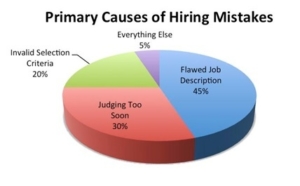
According to Lou Adler (http://www.recruiterswall.com/ ) there are three primary causes of most hiring mistakes: bad job descriptions, making the assessment too quickly, and basing the hiring decision on criteria that doesn’t predict on-the-job success.
If you don’t solve the “Big Three Hiring Challenges,” better interviewing or sourcing skills won’t help. If you’re not seeing or hiring enough good people, or the people you’re hiring aren’t as motivated as you expected, one of the big three is probably the reason. Here are some ideas on what you need to do:
1. Preparing performance-based job descriptions when starting a search is a great way to clarify expectations up front. As part of writing a job description it’s important that job success is defined as a series of measurable performance objectives. All candidates then need to be evaluated on their ability and motivation to do the work described. This approach opens up the talent pool to a larger group of more diverse and talented prospects by converting jobs into career opportunities.
2. Delaying the yes/no hiring decision until all the evidence is evaluated eliminates many common hiring mistakes. A series of short 30-minute interviews or instant judgments based on first impressions, affability, or communication skills are a recipe for making the wrong decision. Ensuring objectivity is a critical step in evaluating competency, fit, and motivation. If you’ve ever lost a good candidate due to a narrow, superficial, or biased assessment, you know how important it is to separate performance and presentation.
3. Conducting a pre-hire performance review ensures the right factors are fully evaluated. Success is much more than raw technical ability or possessing a set of desirable competencies. How a person’s skills and abilities are used on the job, a track record of achieving consistent results, collaborating with others, and how decisions are made are far better predictors of success. All of this must be filtered by actual job needs, the manager’s leadership style, and the company culture. Collectively, this is what drives motivation, satisfaction, and on-the-job success.